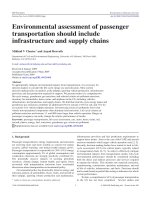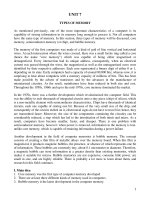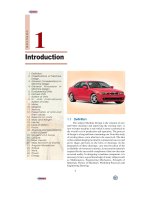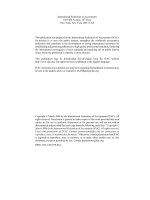- Trang chủ >>
- Khoa Học Tự Nhiên >>
- Vật lý
Tài liệu Esoteric Theory of Everything docx
Bạn đang xem bản rút gọn của tài liệu. Xem và tải ngay bản đầy đủ của tài liệu tại đây (362.39 KB, 6 trang )
Esoteric Theory of Everything – Lee Bladon ©2007
Esoteric Theory of Everything
Introduction
For many decades, scientists have been trying to devise a single unified theory to explain
all known physical phenomena, but a model that appears to unite the seemingly
incompatible String Theory and Standard Model has existed for 100 years. It described
baryons, mesons, quarks and preons over 50 years before conventional science. It stated
that matter is composed of strings 80 years before string theory. It described the existence
of anti-matter 30 years before conventional science. It described the Higgs field over 50
years before Peter Higgs. It described the existence of isotopes 5 years before
conventional science. Could this be the beginning of a Theory of Everything – the holy
grail of modern physics?
Quantum Foam
Quantum foam, also known as space-time foam, is a concept in quantum physics
proposed by Nobel physicist John Wheeler in 1955 to describe the microscopic sea of
bubbling energy-matter. The foam is what space-time would look like if we could zoom in
to a scale of 10
-33
centimetres (the Planck length). At this microscopic scale, particles of
matter appear to be nothing more than standing waves of energy. Wheeler proposed that
minute wormholes measuring 10
-33
centimetres could exist in the quantum foam, which
some physicists theorise could even be hyper-spatial links to other dimensions. The hyper-
spatial nature of the quantum foam could account for principles like the transmission of
light and the flow of time. Some scientists believe that quantum foam is an incredibly
powerful source of zero-point energy, and it has been estimated that one cubic centimetre
of empty space contains enough energy to boil all the world’s oceans.
So, if we could describe a microscopic standing wave pattern that appeared particle-like
and incorporated a vortex within its structure, we might have the basis for a theory that
could unite all the current variants in modern physics. Figure 1 appears to meet these
criteria – it is a drawing of a subatomic particle reproduced from Occult Chemistry by
Charles Leadbeater and Annie Besant, which was first published in 1909, although a
similar diagram was published in a journal in 1895. Leadbeater explains that each
subatomic particle is composed of ten loops which circulate energy from higher
dimensions. Back in 1895, he knew that physical matter was composed from “strings” – 10
years before Einstein’s theory of relativity and 80 years before string theory.
Figure 1 – Subatomic particle
www.esotericscience.org/articles/5a.pdf Page 1 of 6
Esoteric Theory of Everything – Lee Bladon ©2007
String Theory and the Standard Model
According to Leadbeater these particles are composed of 10 vibrating strings, which are in
turn composed of even smaller particles, which are in turn composed of even smaller
strings, etc… This suggests that the seemingly incompatible standard model and string
theory may in fact be two sides of the same coin.
String theory proposes that everything is composed of incredibly minute strings or loops of
energy-matter vibrating in ten (or more) dimensions. Our brains can only comprehend four
dimensions – the three spatial dimensions (length, width and height) plus one temporal
dimension (time). So according to string theory, six (or more) hidden spatial dimensions
must exist beyond our perception. It is interesting to note that the ancient cosmologies of
eastern religions are based on seven planes of existence, with our physical plane being
the lowest.
According to Leadbeater the fundamental particle shown in Figure 1 is merely the
fundamental particle of our physical dimension (plane 1) – for this reason I will refer to it as
the 1-atom. 1-atoms are so small that modern science has not yet detected them, but they
were theorised back in 1974 by Jogesh Pati and Abdus Salam, who referred to them as
“preons”. According to Leadbeater, two varieties of 1-atom exist (positive and negative),
each with the same basic structure but the spirals spin the other way in the negative
variety (see Figure 2). This is due to zero point energy flowing down through the negative
atoms and up through the positive atoms.
Figure 2 – Positive and negative 1-atoms
The negative particles are not electrons; they are antiparticles. A particle of antimatter has
the same mass and magnitude as an equivalent particle of regular matter but an opposite
charge. For example, the antiparticle of an electron is a positron. A positron is identical to
an electron in every way except that it has a positive charge. The existence of antimatter
was not predicted by conventional science until 1928 and confirmed experimentally in
1932, yet Leadbeater knew about it over 30 years earlier.
Even More Fundamental
1-atoms are far from being the ultimate fundamental particle from which everything in the
universe is composed. Each 1-atom is composed of ten separate “strings” (closed loops)
which are in turn composed of coiled loops of even smaller particles – see figure 3.
www.esotericscience.org/articles/5a.pdf Page 2 of 6
Esoteric Theory of Everything – Lee Bladon ©2007
Figure 3 – The microstructure of “strings” in a 1-atom
1-atoms are the fundamental particles of the physical plane (plane 1), 2-atoms are the
fundamental particles of plane 2, 3-atoms are the fundamental particles of plane 3, etc.
According to Leadbeater, each 1-atom is composed of forty nine 2-atoms, each 2-atom is
composed of forty nine 3-atoms, each 3-atom is composed of forty nine 4-atoms, etc. The
matter of the lower planes is composed of the matter of the higher planes, so all the planes
can interpenetrate each other and occupy the same space. Figure 3 shows the number of
fundamental atoms from the various planes that make up one fundamental atom of the
physical plane.
Figure 4 – The number of “subtle” atoms in one 1-atom
Phases of Matter
www.esotericscience.org/articles/5a.pdf Page 3 of 6
In addition to the four phases of physical matter (solid, liquid, gas and plasma) recognised
by modern science, the alchemists of old recognised a fifth element. They believed
everything was created from the five elements: Earth (solid), Water (liquid), Wind (gas),
Fire (plasma) and Aether (ether). They recognised aether as a phase of subtle matter that
filled all space and supported the propagation of electromagnetic waves (e.g. light and
magnetism). According to Leadbeater there are actually seven phases of physical matter;
and where that ends different kinds of even subtler matter begin. The three lowest phases
of physical matter (1:1, 1:2 and 1:3) broadly correspond to solid, liquid and gas. The four
higher phases of physical matter (1:4, 1:5, 1:6 and 1:7) are etheric, and are what science
refers to as subatomic particles or dark matter. 1-atoms belong to the 1:7 phase and
combine in many different molecular permutations to produce the hundreds of sub-atomic
particles and chemical elements known to science.
Esoteric Theory of Everything – Lee Bladon ©2007
Figure 5 depicts the subatomic structure of a hydrogen atom as described by Leadbeater a
hundred years ago. The nucleus is composed of six units (in two groups of three), and
each unit is composed of three 1-atoms. According to conventional science the nucleus of
a hydrogen atom is composed of only three units called quarks.
Figure 5 – The subatomic structure of a hydrogen atom (not to scale)
Figure 6 shows that Leadbeater’s model has precisely twice as many particles as the
standard model suggests. This is because 50% of the 1-atoms in Leadbeater’s model are
negatively charged (antimatter).
Figure 6 – Subcomponents of a hydrogen nucleus
Conventional science doesn’t consider it possible for antimatter to be a constituent part of
physical matter because the matter and antimatter would annihilate each other if they ever
touched, but they have no reason to touch under normal circumstances. According to
Leadbeater, even the 10 strings of a 1-atom never touch each other. If a positive 1-atom
(matter) did come into contact with a negative 1-atom (antimatter) each would breakdown
into 49 2-atoms. 2-atoms are so subtle that conventional science regards them as pure
energy (dark energy).
Conventional science cannot account for the disappearance of all the antimatter that was
produced in the Big Bang. According to the Big Bang theory, equal amounts of matter and
antimatter were created at the birth of the universe, but scientists can’t explain why so little
of it exists today. Could it be that all the “missing” antimatter is hidden within regular
matter?
Figure 7 depicts the subatomic structure of a hydrogen atom (in the 1:3 gaseous phase)
and its decomposition through four etheric phases:
• The 1:4-molecules are baryons.
• The large 1:5-molecules are unstable mesons.
• The small 1:5-molecules and the 1:6-phase molecules are quarks.
• The 1:7-atoms (or 1-atoms) are preons.
www.esotericscience.org/articles/5a.pdf Page 4 of 6
Esoteric Theory of Everything – Lee Bladon ©2007
Leadbeater did not state what the membranes surrounding the molecular structures are
composed of, but they are probably 2-atoms or 3-atoms.
Figure 7 – The decomposition of hydrogen
Figures 1, 2, 3, 5 and 7 are extracted from Occult Chemistry by Charles Leadbeater and
Annie Besant. The book depicts the subatomic structure of every element in the periodic
table from Hydrogen to Uranium, including various isotopes (atoms with the same atomic
number but different mass numbers). Leadbeater knew that isotopes existed in 1907 – five
years before conventional science discovered them.
The Higgs Field
The Higgs field is a quantum field that is believed to permeate the entire universe. The
theory was proposed by physicist Peter Higgs in the 1960s to account for the fact that that
particles have mass. Particles of matter that interact with the Higgs field are subject to
resistance, which shows itself as mass. Particles that interact strongly with the Higgs field
are heavy, while those that interact weakly are light. The Higgs field has been compared to
treacle through which every particle in the universe has to “swim”. Small particles can
easily move through the Higgs field so they appear to have negligible mass, but large
particles create more drag so appear to be heavier.
Leadbeater described something very similar to the Higgs field over 50 years earlier in
Occult Chemistry. He explained that an incredibly dense substance, which he called
koilon, permeates the entire universe, and that every atom of matter corresponds to an
empty bubble in this incredibly dense substance. It helps to think of the universe as a
mirror image of another reality (the anti-universe) where empty space is not empty but is
filled with dense koilon, and where particles are not matter but are empty bubbles. If our
universe is positive existence, then the anti-universe is negative existence (see Figure 8).
When a particle moves, its corresponding bubble must move through the dense koilon and
this causes resistance. This resistance manifests as inertia in the particle, and inertia gives
the appearance of mass. Large particles correspond to large clusters of bubbles which are
subject to greater resistance, giving the appearance of a large mass. Small particles
correspond to small clusters of bubbles which are subject to less resistance, giving the
appearance of a small mass.
www.esotericscience.org/articles/5a.pdf Page 5 of 6
Esoteric Theory of Everything – Lee Bladon ©2007
www.esotericscience.org/articles/5a.pdf Page 6 of 6
Figure 8 – Empty bubbles in koilon in the anti-universe correspond
to particles of matter in our universe
Bose-Einstein Condensate
The koilon (or Higgs field) that fills the anti-universe is an incredibly dense, homogenous
and fluid “sea” of negatively existing matter. Everything is reversed in our universe, so
matter is incredibly subtle in the higher planes and increasingly dense in the lower planes.
It therefore follows that something corresponding to the incredibly dense, homogenous
and fluid “sea” of koilon should exist below the physical plane. In 1924 Satyendra Bose
and Albert Einstein predicted the existence of just such a phase of matter – they called it
Bose-Einstein condensate (BEC). But it was not until 1995 that the technology existed for
it to be produced in a laboratory. Eric Cornell and Carl Wieman, of JILA at the University of
Colorado, cooled rubidium atoms to less than 170 billionths of a degree above absolute
zero, which caused the individual atoms to condense into a collective “superatom” which
behaved like a single fluid entity. Bose-Einstein condensate is not physical matter but
something just below it. It is a phase of matter that has completely different properties to
any other kind of matter known to science.
Atoms in a gas at room temperature move at about 1,000 miles per hour. They slow down
to about 1 metre per hour as the temperature approaches absolute zero, but the atoms in
a BEC barely move at all. When the atoms stop vibrating they are able to share the same
space, since atoms are 99.999999% empty anyway. Bose-Einstein condensate can only
exist at absolute zero (-273°C); a temperature so cold that the energy aspect of energy-
matter becomes zero. Absolute zero is the baseline that prevents creation from
descending any lower – it is quite literally the bottom of the universe.
The Sanskrit word “Avichi” (meaning waveless) describes the lowest possible state of
existence and clearly refers to the non-vibrational state of Bose-Einstein condensate. The
ancient Hindu scripture the Srimad Bhagavatam 5.26.5 states that the “Garbhodaka
Ocean” lies at the bottom of the universe – this clearly refers to the “sea” of Bose-Einstein
Condensate that exists below the physical plane. In Kabbalah, “Klipoth” (the abyss that lies
below the physical plane) also refers to the Bose-Einstein state.
It seems that conventional science can learn a lot from unconventional sources!









